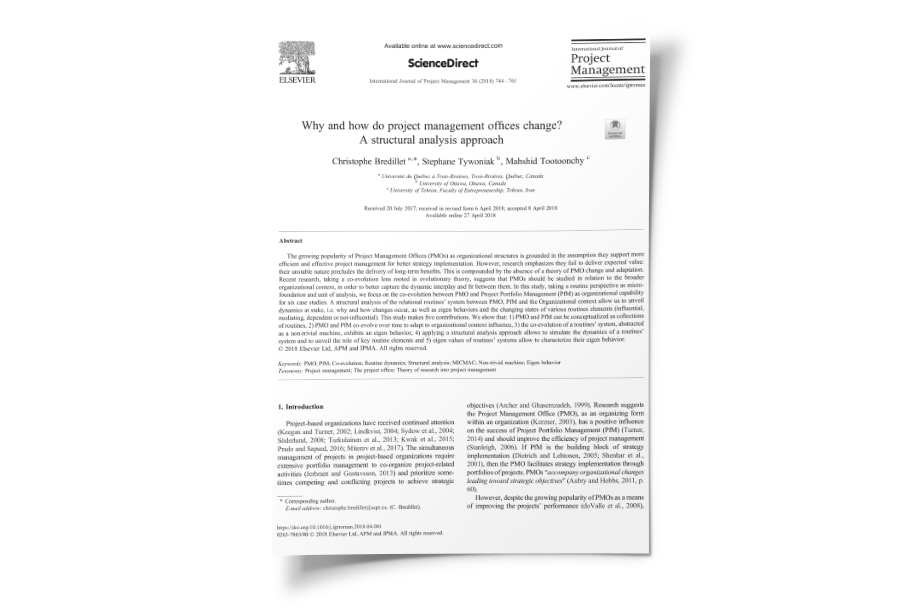Why and how do project management offices change? A structural analysis approach
Abstract
The growing popularity of Project Management Offices (PMOs) as organizational structures is grounded in the assumption they support more efficient and effective project management for better strategy implementation. However, research emphasizes they fail to deliver expected value: their unstable nature precludes the delivery of long-term benefits. This is compounded by the absence of a theory of PMO change and adaptation. Recent research, taking a co-evolution lens rooted in evolutionary theory, suggests that PMOs should be studied in relation to the broader organizational context, in order to better capture the dynamic interplay and fit between them. In this study, taking a routine perspective as micro-foundation and unit of analysis, we focus on the co-evolution between PMO and Project Portfolio Management (PfM) as organizational capability for six case studies. A structural analysis of the relational routines’ system between PMO, PfM and the Organizational context allow us to unveil dynamics at stake, i.e. why and how changes occur, as well as eigen behaviors and the changing states of various routines elements (influential, mediating, dependent or not-influential). This study makes five contributions. We show that: 1) PMO and PfM can be conceptualized as collections of routines, 2) PMO and PfM co-evolve over time to adapt to organizational context influence, 3) the co-evolution of a routines’ system, abstracted as a non-trivial machine, exhibits an eigen behavior, 4) applying a structural analysis approach allows to simulate the dynamics of a routines’ system and to unveil the role of key routine elements and 5) eigen values of routines’ systems allow to characterize their eigen behavior.
Potential Industry Impact
- By involving the projects’ teams in identifying the problems and discussing the possible solutions, the PMO can facilitate the process of team building. Team building can help the project team to enhance their social relations, improve the practice and share the same vision.
- The conceptual framework can be used as a diagnostic reading tool to identify the main PMO-PfM routines and the way they are interrelated. PMO executives can use the model to facilitate auditing the PMO-PfM relations. …
- One major challenge of PMOs is knowledge management. Diagnostic, identification of potential problems and team problem-solving and simulation can significantly improve knowledge management via lessons learned, consensus building, joint knowledge creation and transfer, as well as contributing to improve and develop both individual competences and organisational capabilities.
Academic Impact
- The extant literature states that PfM is a “dynamic decision process” (Cooper et al., 1997, p. 16; Müller et al., 2008, p. 28). Our research findings reveal that PfM is an organizational capability and therefore can be conceptualized as a set of routines. The examples from the Proteus case study illustrate and explain how conceptualizing PfM as a collection of routines helps us to track the continual changes in PfM routines.
- Pellegrinelli and Garagna (2009) state that PMOs should act as change agents. The patterns of PMO and PfM co-evolution evidenced in our study suggest that the PMO should not be the sole agent of change in the organization; changes and the new requirements of PfM can be trigger evolutions in the PMO. Therefore, evolution has two directions: 1) When the observation of PfM enactments by PMO executives requires the structure or processes of PfM to transform (intentional variation) the PMO is the change agent. 2) When project/portfolio managers choose different enactments of routines to better fulfil their roles, the new and successful practices of project/portfolio managers lead to new routines (unintentional variation) that can trigger changes in actions, processes, or structures at the level of the PMO. Overall, the PMO and PfM co-evolve; one is the change agent of the other.

Christophe Bredillet, Stephane Tywoniak, Mahshid Tootoonchy
Journal:
International Journal of Project Management, Volume 36, Issue 5 (July, 2018)
Read:
https://doi.org/10.1016/j.ijproman.2018.04.001



Leave a Reply